(former Director of Centre for London)
Structural Changes in World Cities: What constitutes a fascinating city in the post-COVID-19 era? Part 2 Panelist Presentations
Roppongi Academyhills Towerhall

(former Director of Centre for London)



**Please note that following presentations were made based on information as of Nov. 2020, and some information might have been updated or altered since then.
“How are life and work styles responding to Covid-19?”
Mr. Ben Rogers
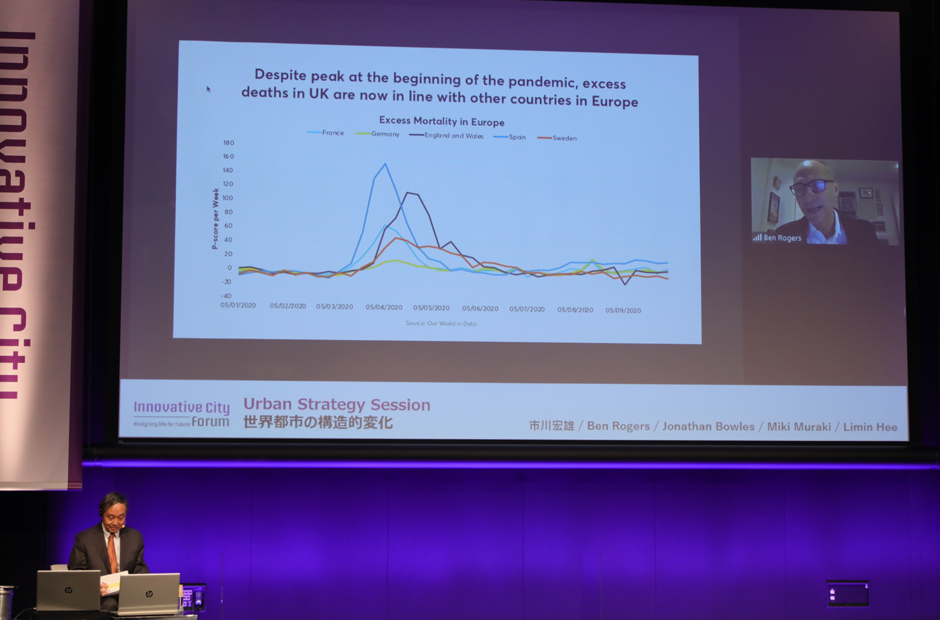
Ben Rogers
The pandemic has hit the UK hard, and particularly in the early days we were one of the most severely hit countries in the EU.
London was hit first, of all the UK regions. Other regions particularly in the north of England now have higher rates of COVID. London is now one of the areas which has got the lowest rates of COVID.
The economic impact in London
Despite the fact that actually London has not been as badly hit by COVID in terms of the prevalence of the disease, its economy has taken a real hit.
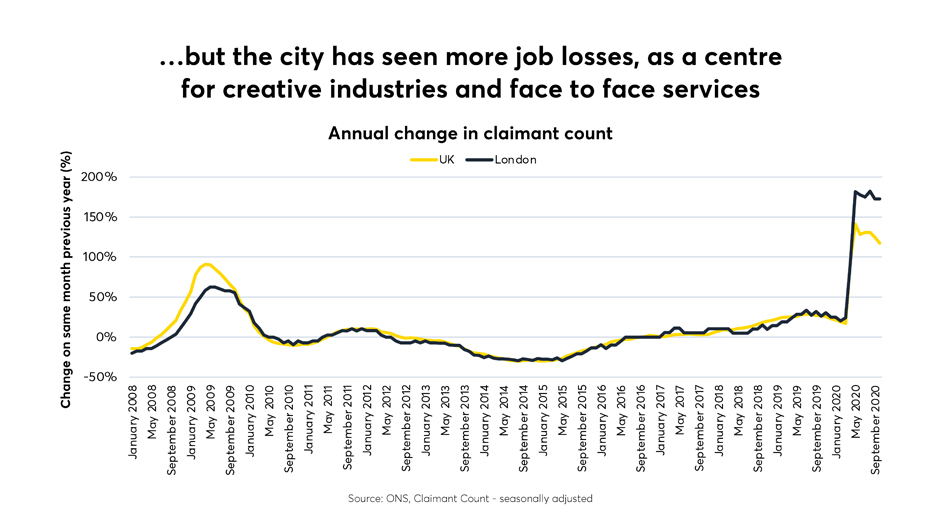
This is about job losses, and the graph shows the number of people who are claiming unemployment benefit. And you can see that London has got a higher rate, higher increase in the number of people claiming jobless benefits compared to the whole UK. This is probably just because of the prevalence of industries which depend on face-to-face contact, and which have therefore been very negatively affected by lockdown.
Both the hospitality sector, which is huge in London, and the creative industries, the performance industries, and those two things account for a much larger proportion of London's economy than the economy of the UK as a whole.
We've had two lockdown periods in the UK. The first was from basically from the end of March until June. Then a second one which has started on November 5th, and ends next week (Dec 2nd).
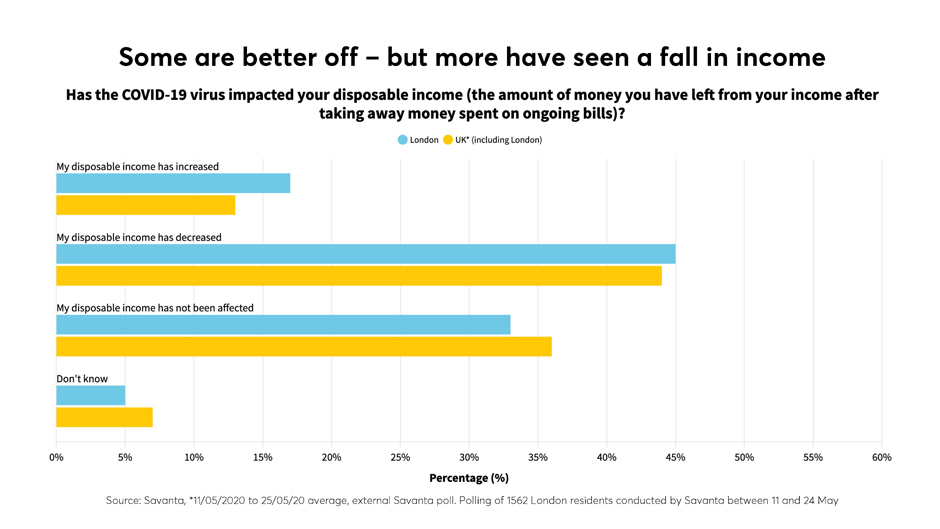
This is a survey which we asked people whether they were better off or worse off as a result of the pandemic, particularly with regard to their income. A significant proportion (17%) of Londoners say that they are better off which is more than across the UK as a whole. And those are people who have been able to work from home, make savings on travel costs, perhaps make savings on childcare costs. But a much more significant number say that they are worse off. In London, about 45% of Londoners are worse off in terms of income as a result of the pandemic.
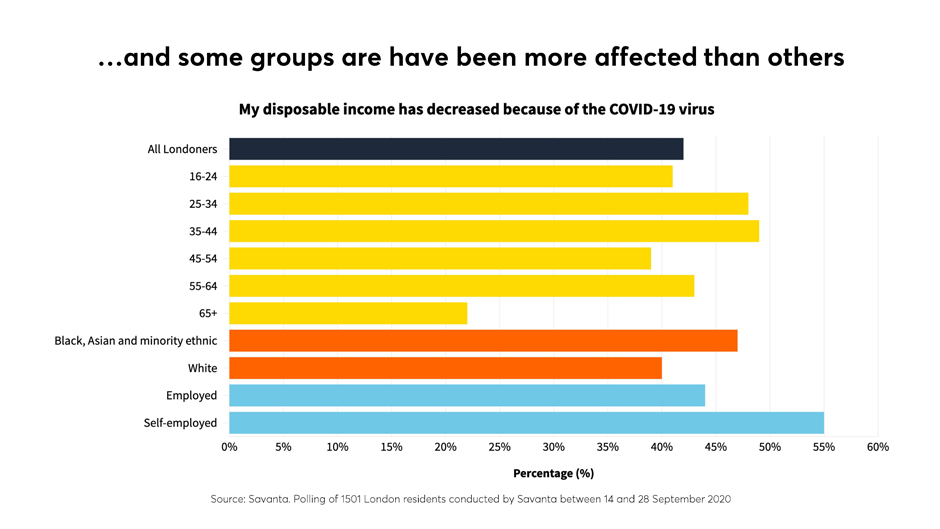
This varies very significantly across different groups.
Looking at the age groups 65+, people who have retired from work have not seen a big decline in their disposable income because of course their income is largely in the forms of pensions. The age groups which have been hit hardest, are the prime working age 25 to 44.
And then a big divergence in ethnicity. Black, Asian, and minority ethnic Londoners are significantly more likely to say that they are worse off as a result of the pandemic and they are also much more likely to have fallen ill and have died unfortunately than white Londoners.
The impact in people’s movement

We've seen a really profound collapse in public transport use in London. Londoners are much less likely to be going to work than almost any other major global city. We've had falls of sometimes up to 90% in the use of the Tube in particular.
This has not just hit Central London's economy very hard; it's hit the finances of Transport for London very hard as well. Transport for London relies to a very unusual extent on fare income and very little income from sources other than fares. So a collapse in fare income has been disastrous for its finances.
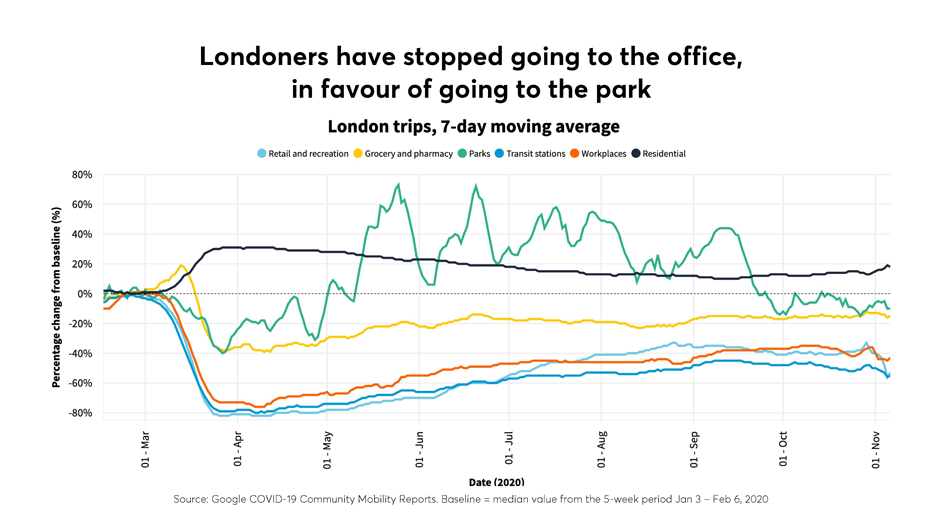
This is just a chart looking at where people are spending their time since the pandemic, until the present. There’s a big fall in people spending time in their workplace, not surprisingly. Perhaps more surprisingly is we saw, over the summer in particular, a really big increase in the amount of time people were spending in London's parks. We've seen a real growth in appreciation of the role that parks and local neighborhood amenities in the public realm can play in our lives.
Central London has been hit most negatively by the pandemic. We really can talk about sort of crisis and economic crisis for Central London. This isn't really surprising if you think that how much London has depended on the visitor economy, on overseas tourists, the national tourists, and how much it depends on commuters. Once you take those two things away, there's not much of the Central London's economy left.
Are Londoners leaving?
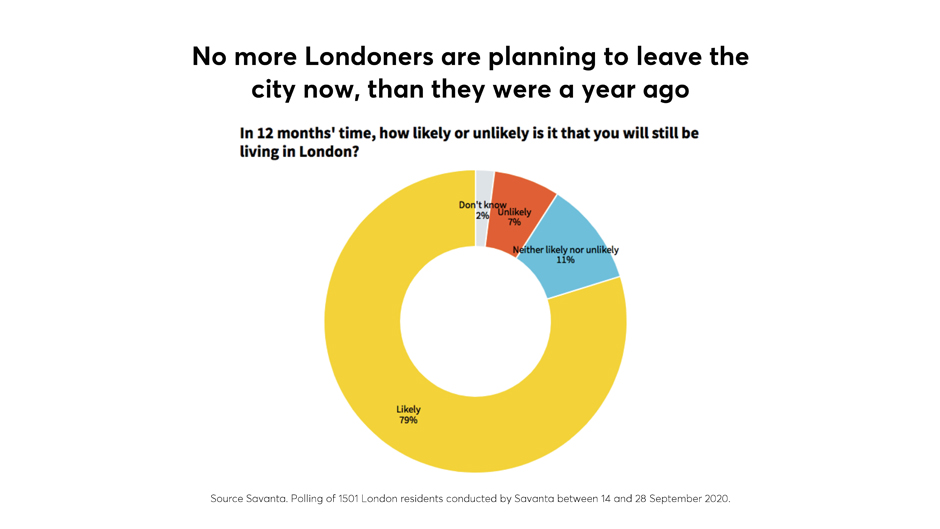
We did a survey just asking people whether they were likely to leave London in the next year. To our surprise, only 7% said they were unlikely to be in London in a year's time, which is pretty much the rate previously. So it does suggest actually that the pandemic isn't having a big impact on Londoner’s plans to stay in or leave the city.
“How the COVID-19 Pandemic is Transforming New York City”
Mr. Jonathan Bowles
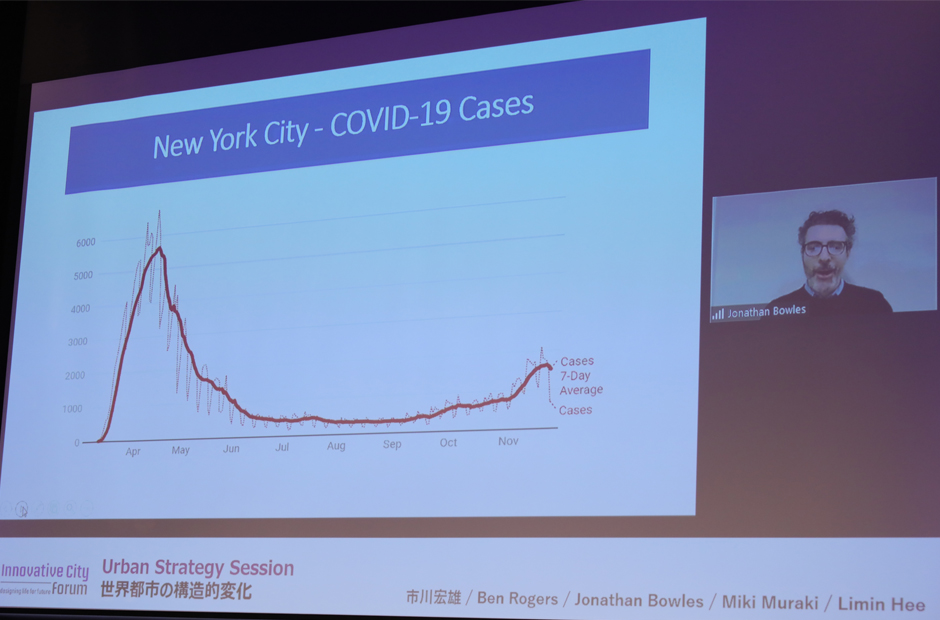
Jonathan Bowles
New York has gone through a number of severe challenges over the past two decades, 9/11 and the terrorist attacks. We had a financial crisis that hit New York hard, but I think the COVID crisis is really taking things to a whole other level.
New York was really the public face of COVID globally. At one point there were more than 8,000 new COVID cases in a single day in New York in April.
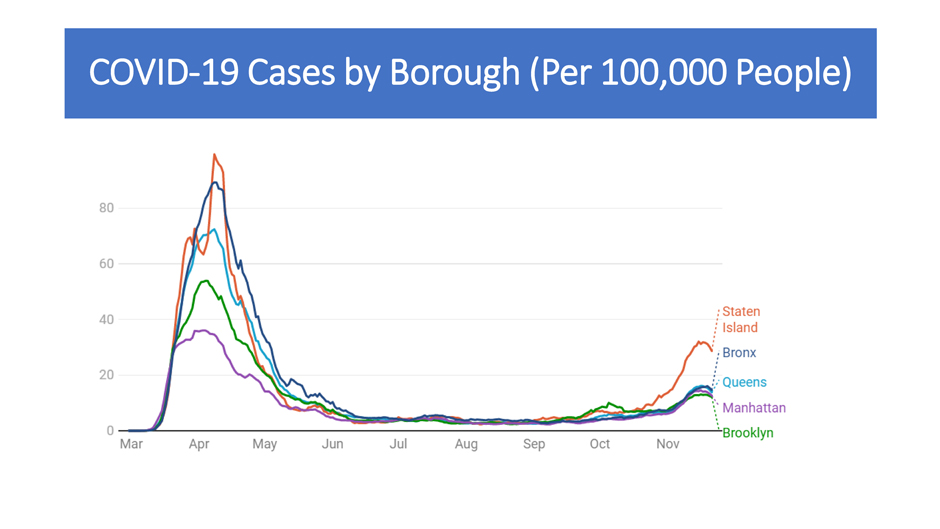
This slide shows the cases per 100,000 people by the five boroughs. What is interesting about this is that the borough of Staten Island had the most cases in the beginning and has maintained that including to the present day. Staten Island is the least dense part of New York which punctures the perception that COVID is a disease that's hitting a dense city the hardest.

I want to go back and talk about the arc of this disease in New York because we did see an extraordinary number of deaths in April and in early May in New York we saw so many cases. But the city since then has really bounced back. Through from June until the present, COVID cases have really remained low. That really helped New York because for so long it was really the poster child of what was wrong in a response to COVID, and I think New York has really come back fairly strong since then.
The policies taken in New York City
I want to talk about some of the policies that New York has implemented to try to get this in order.
- ・New York shut down non-essential businesses and issued strict social distancing rules. It issued a mask mandate earlier than most places in the United States. Those were extremely successful in reversing the spike in cases of COVID. It helped reduce community spread.
- ・New York was very smart in having a phased reopening by region across the State of New York so that cities and regions had to meet a certain threshold of caseloads, of safety levels before they were allowed to open. And they were allowed to open only a bit at a time. This helped keeping the virus from roaring back.
However, there were some missteps in New York.
- ・The stay-at-home order in New York came almost a week after San Francisco, and that delay allowed massive community spread and cost thousands of lives.
- ・The State of New York ordered nursing homes to accept COVID patients from hospitals. I think this turned out to be a mistake. We've seen in New York as with other places, but more severely here, the number of deaths in nursing homes was staggering.
- ・There was an order in the first couple of weeks for hospitals to increase capacity by 50%. This made sense for a number of reasons but also led to some healthcare mistakes that accelerated deaths from the virus.
There are some other policies that go beyond healthcare measures that had been really interesting and are worth sharing.
- ・New York City's Economic Development Agency coordinated with local manufacturing companies to make masks, gowns, testing kits, and ventilators. They really added some crucial capacity during a period where the hospitals were overwhelmed; the federal government in the United States was not producing or taking steps to help New York get those crucial pieces of equipment.
- ・There were also some other regulations relaxed around TeleHealth services. At a time when a lot of people wanted medical care but didn't want to necessarily go into a doctor's office or a hospital. This was a crucial step that was taken.
- ・The state and the city also issued a moratorium on evictions, to make sure that vulnerable people who have lost income were not kicked out on to the street.
- ・New York also expanded unemployment insurance to cover independent workers. We all know that we've seen such a huge increase in people working in the gig economy and independent work these days.
There were other policies that were implemented as well.
- ・This year the city legalized e-scooters and e-bikes. It supported the surging demand for micro-mobility options in New York.
- ・The city accelerated a plan to provide affordable broadband for low-income residents. I think we've all seen that the digital divide is such an important and growing challenge for cities to meet the demand as so many New Yorkers are going to school and work virtually these days.
The launch of “Open Street” and “Outdoor Dining”
What else have we seen has changed? What are the changes in workstyle and lifestyle?
I think one of the things that's similar to London, people have gotten outside. The city launched open street and outdoor dining. This has helped restaurants survive. It's revived street life around the city and it's boosted the city's vibrancy.
In New York I think people have gotten outside and dined out at restaurants more than ever. The city made it very easy for restaurants to open up outdoor dining within streets where parking spots used to be. This didn't happen before in New York.
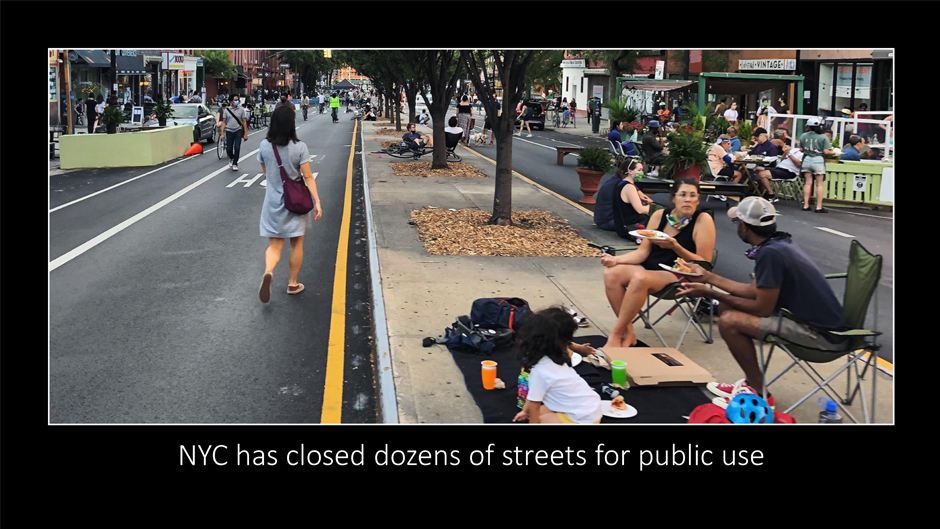
New York has closed dozens of streets from car traffic to pedestrian. This has I think been one of the real important adjustments for New York. With so many people cooped up in their apartments and homes, New Yorkers have gotten outside in huge numbers.
Changes in transportation
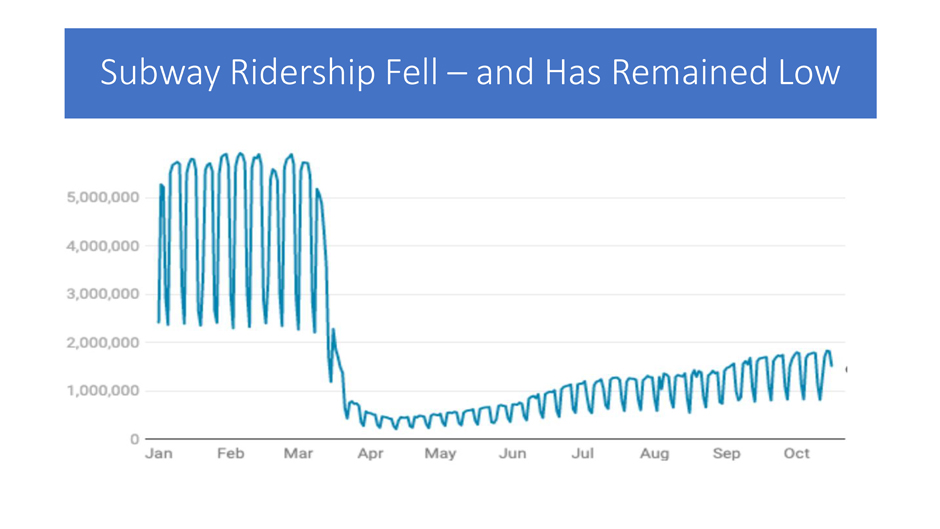
Like in London, subway ridership has fallen significantly. Even today, subway ridership is only about 30% of what it was pre-pandemic. This is a huge change in commuting patterns.
We have seen bike usage in New York grow pretty significantly. A lot of it is for leisure. People are riding around their neighborhoods in new levels. But when they are going to work, we're seeing a lot of people scared to take the subway, they are using a bike to get to work and the city has expanded bike lanes to make that accommodating.
Are the people leaving New York?
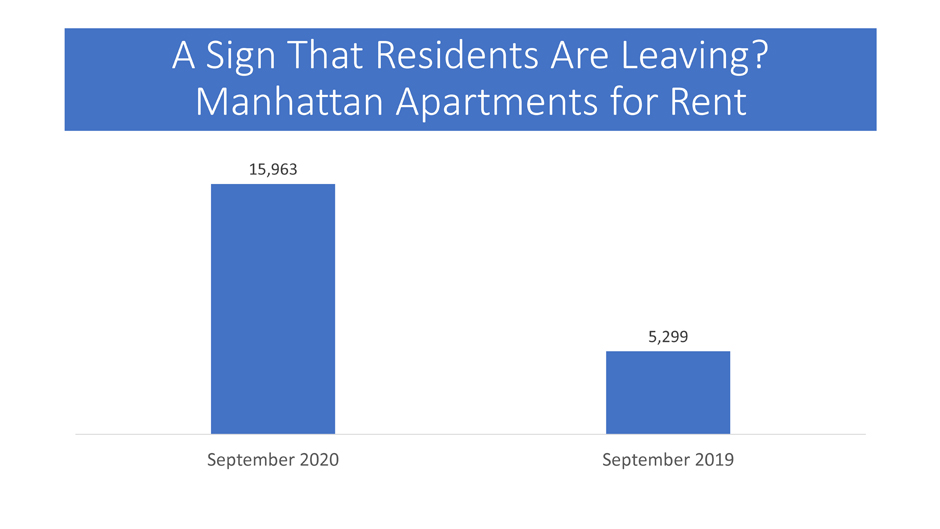
The “Introduction” survey results mentioned that New York was one of the cities where we might see people moving out. And in fact, the numbers of open vacant rental apartments in Manhattan suggests that that is probably happening. I am not sure that there's a massive exodus, but this alone shows that in September of 2020 there were about 16,000 vacant apartments in Manhattan; at the same time last year, there were one-third as many.
So far only about 10% of Manhattan's office workers have come back to their desks. This doesn't include all jobs. A lot of services workers have gone back to their work. But people working in Manhattan offices, only about 10% have gone back to work so far.
One of the things that concerns us the most is unemployment and the economy. New York City was on par with the national average in the United States with unemployment: 3.6% for the nation and 3.7% in New York City. But today, the unemployment rate in New York is almost double the rate for the United States. New York has a disproportionate share of the industries that have been hit the hardest. Hotels, hospitality, restaurants, nail salons, childcare services, a lot of the other services work that has been hit the hardest in this.
“New life in Tokyo after COVID-19”
Ms. Miki Muraki

Miki Muraki
Looking back at the situation in Tokyo when the state of emergency was declared, there was a noticeable absence of people in the city. There persists a vague anxiety of not knowing how long COVID-19 will last, and to this day there remains an ongoing concern as to how long we should continue to wear masks. I saw the situation where people got caught up in fake news, rushed out to buy masks and toilet paper, and emptied the shelves of goods, and I felt a genuine sense of fear that I would no longer have access to everyday essentials.
How should we consider life post-COVID-19?
Japan is currently examining the rapid progress in digitalization and urban policies in response to the new normal triggered by the novel coronavirus. There are four points to consider here.
- ・How will future lifestyles change in response to this new normal?
- ・How will urban assets be utilized? How will services change?
- ・How do we acquire and utilize data related to urban development?
- ・Who will create the city? The body responsible for town planning, the way of management, and the way of support.
New demands and changes seen from the novel coronavirus
Going out – location and range
A large number of Japanese people have demonstrated a tendency to spend more time around their homes. Data also shows that while outings around the vicinity of the home increased, the proportion of people who went out away from home into the city center decreased considerably. A distinctive feature of COVID-19’s influence is that the locations and range of movement have been greatly reduced.
The rapid expansion of telework
While telework, which had been suffering a slow progress in Japan, has suddenly spread rapidly, its impact on the infrastructure of transportation, such as railroads, buses, and aviation has been significant. However, a lot of people still place a great deal of value on office discussion and face-to-face communication, and as such the demand for the office will continue to be strong.
The need for small offices in the suburbs
In standard Japanese housing, children's rooms typically exist, but that is not the case in relation to a room for the mother or father to use (a study). As a result, a problem is created as to where to actually conduct telework. In particular, for those who have purchased housing in the suburbs, securing space for work becomes an important factor in the advancement of telework. If such a study or workspace cannot be made in the home, small offices in the suburbs will become a necessity, in order to provide the space where work can be done outside of the home.
Workation
A new work style, called "workation," has emerged that brings together both work and vacation. The idea has arisen, for example, of living in the natural surroundings of Karuizawa, which is only an hour away by bullet train from Tokyo, and then going to a nearby workplace where it is possible to work online with colleagues in Tokyo.
Disaster response
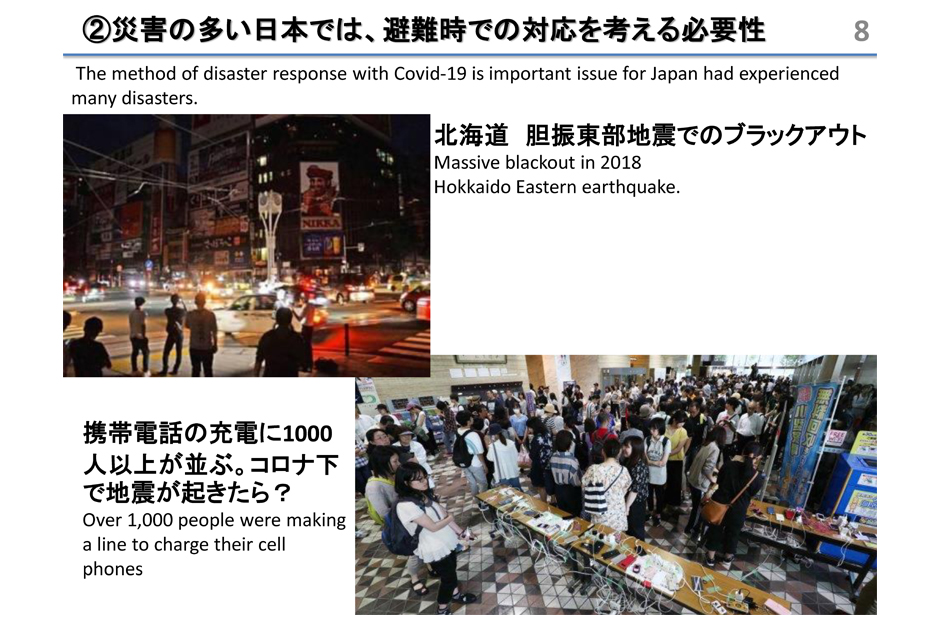
In Japan, a country prone to natural disasters, it is imperative to consider how to respond to the possibility of evacuation during the coronavirus pandemic. Two years ago, during the Hokkaido Eastern Iburi Earthquake, there was a power failure, which resulted in 1,000 people lined up in the mobile phone charging space at the evacuation center. If a similar situation were to happen in Tokyo now amidst the current coronavirus conditions, it would be a catastrophe.
Further Smartification
What has been done elsewhere that couldn’t be done in Japan?
Mentioned earlier was the example of outdoor dining in New York, but it would be difficult to implement this in Tokyo. However, with the aim of avoiding “The Three Cs” and promoting the utilization of road space, a temporary measure up to March 2021 exempts the fee for road usage permits. In order to make better use of sidewalk cafes on the road, it will be essential to introduce a smarter system that provides customers with the convenience to place orders and make payments from anywhere.
Smartification can also be considered in other areas. By using human flow data to understand in advance where ongoing situations are becoming denser, by further expanding the space where you can easily work on the go, and by improving the communication infrastructure such as Wi-Fi, a new way of working in Japan may also be possible. When considering such a system, it is important not to talk about the effects of a single element, but to have a composite evaluation perspective of how we can improve the quality of life of people using cities.
A new evaluation axis for cities
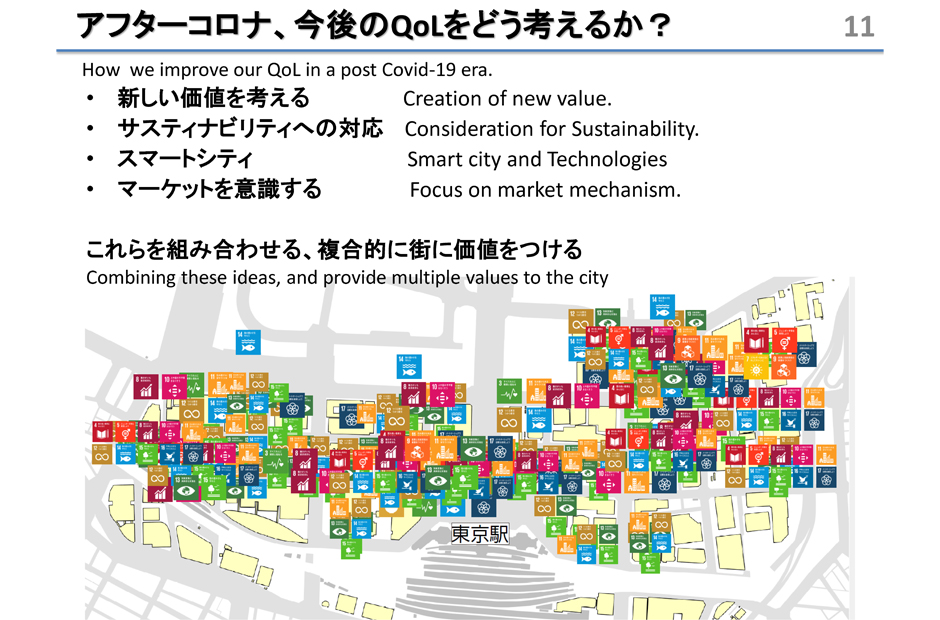
It is important to evaluate the quality of a new city not only from the viewpoint of assessing its physical existence like we used to, such as what kind of things and functions it possesses, but also from the viewpoint of the SDGs, for example, how much it contributes. It will become even more essential to consider the value of the city in a diverse way, such as being aware of the market value of the city through the relationship with the ESG markets.
“Post-Crisis Singapore: furthering healthy city ideas”
Dr. Limin Hee
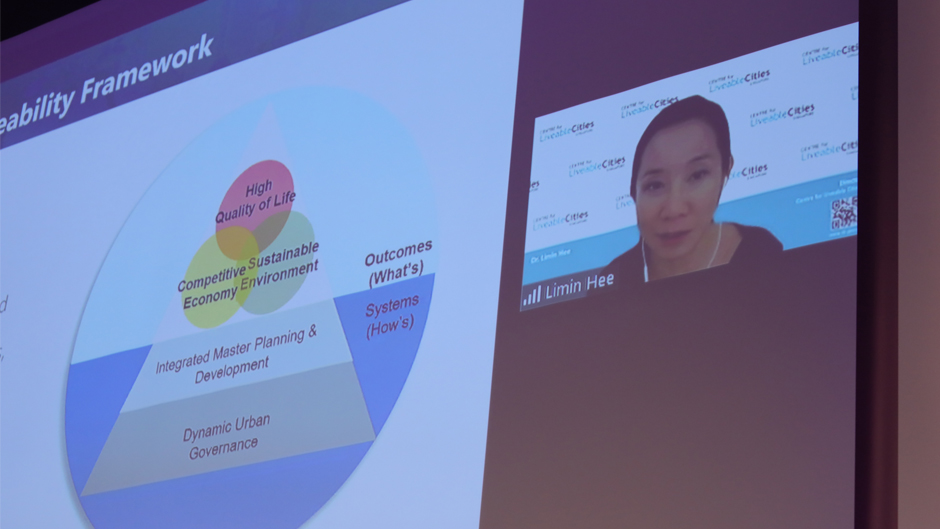
Limin Hee
As you all know, Singapore is a small city-state with a very small land area of just over 720 square kilometers with one of the most dense populations in the world, over 7800 persons per square kilometers. We believe that our success as a dense but livable city has been shaped by the principles captured in the Singapore Liveability Framework. In this framework, the outcomes of a livable city are underpinned by integrated master planning and development as well as dynamic urban governance. We think that these are important principles for building a healthy city which I will go on to explain.
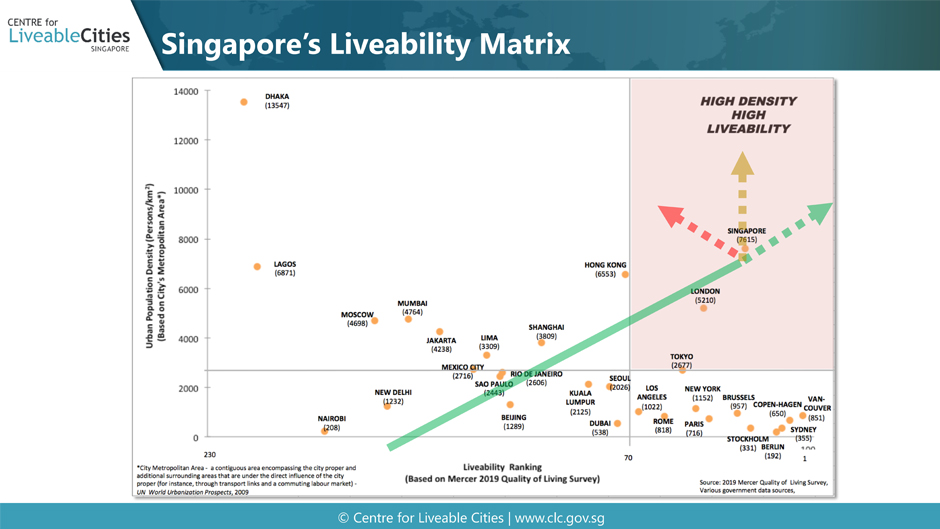
This chart here shows a plot of urban population density against a city's livability ranking based on Mercer's 2019 Quality of Living Survey. And you would see that Singapore is one of the few cities, on the top right, as we are dense but yet have scored well in livability rankings.
Coexist “Dense” and “Livability
We believe that some of the things that we do here has helped us in many ways to remain a livable city even as we grow denser.
City in Nature
When Singapore first became independent in 1965, we called ourselves a “Garden City”. But this has gone through several iterations of being a “City in a Garden”, a “City of Gardens and Water”, and now this year the government has unveiled a new vision for Singapore as a “City in Nature”, where people live in harmony with nature. You can see here on the map, that in Singapore we have preserved four biodiversity cores. Biodiversity is important in how we plan.
Parks & Biophilic Design
We have implemented Active, Beautiful, and Clean Water (ABC Waters) program to naturalize concrete drains to create waterways for residents to enjoy. We have built therapeutic gardens near homes so that elderly and people in wheelchair can easily access these gardens. We've implemented programs such as LUSH(Landscaping for Urban Spaces and High-Rises) that incentivize high-rise building developers to replace the greenery lost on the ground, through sky terraces and roof gardens.
Preparation for pandemics
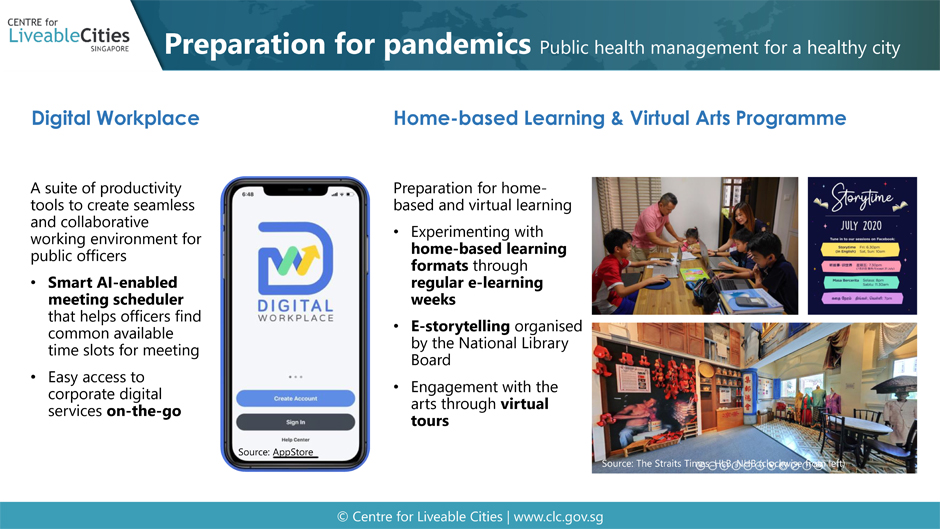
We also introduced our Smart Nation Framework in 2014. When the pandemic struck, many public servants were able to transit to work from home by using apps such as Digital Workplace; similarly e-learning formats were used by the students for home-based learning.
Using technology to adapt
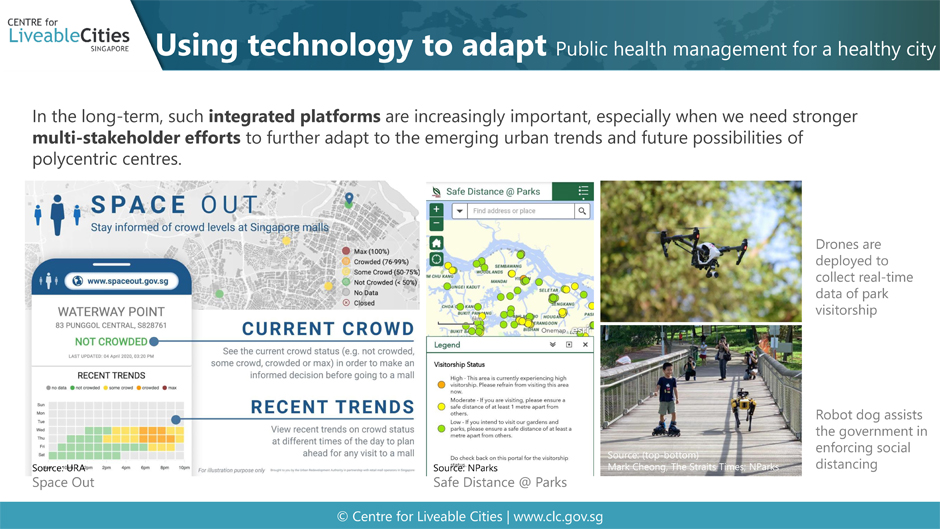
Government agencies have also taken a very integrated approach to how they cooperate with private sector to use technology for us to observe new social norms during the pandemic. For example, the Urban Redevelopment Authority has an app called “SPACE OUT” through which they have worked with mall owners to provide real-time information for people to decide if they want to go to a mall based on crowd levels. The National Parks Board also created an app called “Safe Distance @ Parks” which uses drone technology to provide real-time information to potential park goers.
A new town structural model
Our town planning has followed a new town structural model that implements a hierarchy of town centers and neighborhood centers within each residential town. This helped us to create self-sufficient new towns as well as districts such that when we had to work from home during the pandemic, a lot of amenities were nearby and easily accessible, including parks.
Multi-tasking space
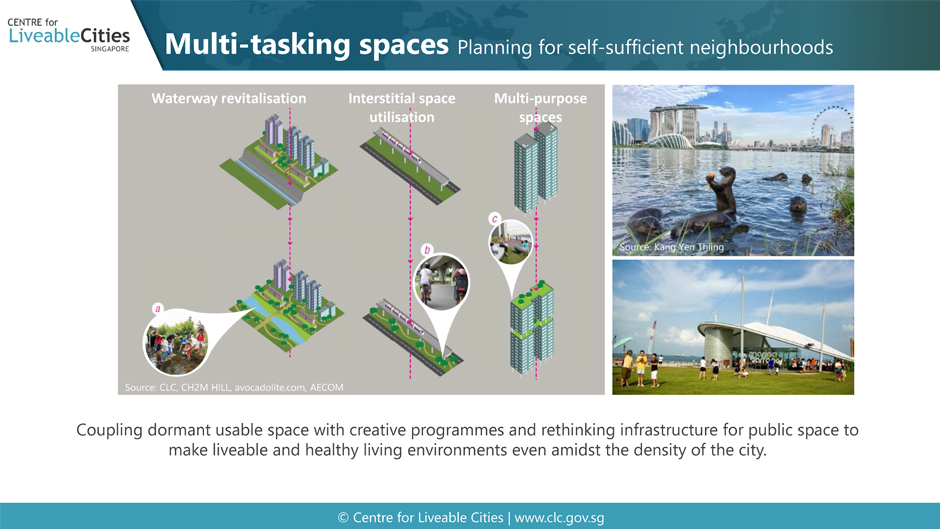
Singapore has also been working hard to use infrastructure space for recreation. Some of the examples are Park Connector Networks (PCNs) which are built on drainage reserves as well as the Marina Barrage where the roof of a pump building is often used as a recreational facility.
Furthering mobility goals
By 2040, our target is for the longest trip anywhere in Singapore to be fulfilled within 45 minutes through walk-cycle-ride mode using public transport or active mobility modes. Within our towns, 20 minutes would be the maximum you need to get to any amenities. We have also been increasing our cycling path so that by 2030 we will have more than 1300 kilometers of cycling paths in Singapore.
Building food resilience
We have been building up our food resilience, especially in view of supply chain disruptions during the pandemic by diversifying our food sources. We plan to be able to grow 30% of our food needs by 2030, and are working to help local companies to expand overseas so that we may import food back through these companies.
Changing social behaviors
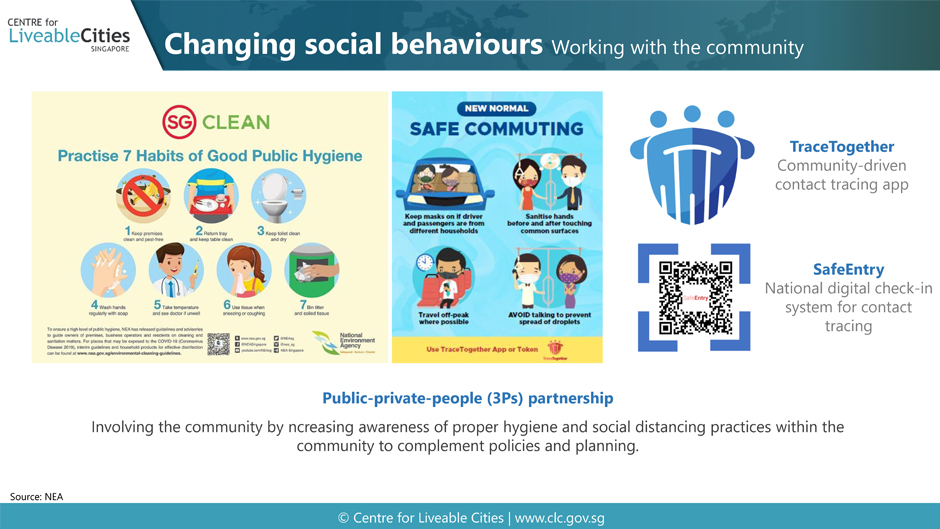
Changing social behaviors has been very important during the pandemic. We have been engaging the public to encourage good and safe social norms. In conjunction with private sector as well as the community, we have launched apps such as “TraceTogether”, a community contact tracing app using Bluetooth, and “SafeEntry”, which collaborates with the private sector so that the personal information of visitors will be captured as they enter a building.
Expanding smart infrastructure

We are revising how we plan for e-commerce and urban logistics to make better use of resources, to coordinate delivery schedules and to plan for using alternative modes of delivery such as drones. At the same time, we have rolled out programs to help individuals and businesses transit to e-platforms. For example, 1000 digital ambassadors have been helping seniors to use digital services in their everyday lives.